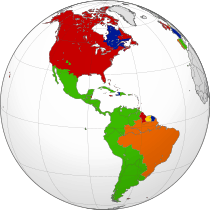List of Indo-European languages
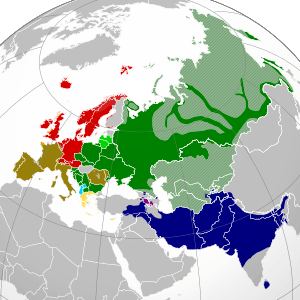
| Part of a series on |
| Indo-European topics |
|---|
 |
|
|
Origins |
|
Archaeology Pontic Steppe Caucasus East Asia Eastern Europe Northern Europe Pontic Steppe Northern/Eastern Steppe Europe
South Asia Steppe Europe Caucasus India |
|
Peoples and societies Indo-Aryans Iranians Europe East Asia Europe Indo-Aryan Iranian |
|
|
The Indo-European languages include some 449 (SIL estimate, 2018 edition[1]) languages and dialects spoken by about or more than three billion and 500 million people (roughly half of the world population), including most of the major languages belonging to language branches and groups of Europe, western and southern Asia, which belong to a single language family. Therefore Indo-European is the biggest language family in the world by number of mother tongue speakers (but not by number of languages in which is the 3rd or 5th biggest). 8 of the top 10 biggest languages by number of native speakers are Indo-European, and one language, English, is the De facto World Lingua Franca with an estimated over one billion second language speakers.
Each subfamily or linguistic branch in this list contains many subgroups and individual languages. Indo-European language family has 10 known branches or subfamilies, of which eight are living and two are extinct. The relation of Indo-European branches, how they are related to one another and branched from the ancestral proto-language is a matter of further research and not yet well known. There are some individual Indo-European languages that are unclassified within the language family, they are not yet classified in a branch and could be members of their own branch.
The 449 Indo-European languages identified in the SIL estimate, 2018 edition[2], are mostly living languages, however, if all the known extinct Indo-European languages are added, they number more than 800 (adding living and extinct). In the case of this list all the known Indo-European languages, living and extinct, are counted.
A distinction between a language and a dialect is not clear-cut and simple because there is, in many cases, several dialect continuums, transitional dialects and languages. Because of this, in this list, several dialect groups and some individual dialects of languages are shown in italics (especially if a language is or was spoken by a large number of people and over a big land area, but also if it has or had divergent dialects).
The ancestral population and language, Proto-Indo-Europeans that spoke Proto-Indo-European, estimated to have lived about 4500 BCE (6500 BP), at some time in the past, starting about 4000 BCE (6000 BP) expanded through migration and cultural influence. This started a complex process of population blend or population replacement, acculturation and language change of peoples in many regions of western and southern Eurasia.[3] This process gave origin to many languages and branches of this language family.
At the end of the second millennium BC Indo-European speakers were many millions and lived in a vast geographical area in most of western and southern Eurasia (including western Central Asia).
In the following two millennia the number of speakers of Indo-European languages increased even further.
In geographical area, Indo-European languages remained spoken in big land areas, although most of western Central Asia and Asia Minor was lost to another language family (mainly Turkic) due to Turkic expansion, conquests and settlement (after the middle of the first millennium AD and the beginning and middle of the second millenium AD respectively) and also to Mongol invasions and conquests (that changed Central Asia ethnolinguistic composition). Another land area lost to non-Indo-European languages was today's Hungary due to Magyar/Hungarian (Uralic language speakers) conquest and settlement. However, in the second half of the second millennium AD, Indo-European languages expanded their territories to North Asia (Siberia), through Russian expansion, and North America, South America, Australia and New Zealand as the result of the age of European discoveries and European conquests through the expansions of the Portuguese, Spanish, French, English and the Dutch (these peoples had the biggest continental or maritime empires in the world and their countries were major powers).
The contact between different peoples and languages, especially as a result of the European discoveries, also gave origin to the many pidgins, creoles and mixed languages that are mainly based in Indo-European languages (many of which are spoken in island groups and coastal regions).
Hypothetical ancestors
Hypothetical relation to other language families and their proto-languages
- Proto-Human (?)
- Several unknown language families and links (?)
- Borean/Boreal (?)
- Nostratic (?)
- Eurasiatic (?)
- Indo-Uralic (?)
- Pre-Proto-Indo-European (?)
- Indo-Uralic (?)
- Eurasiatic (?)
- Nostratic (?)
- Borean/Boreal (?)
- Several unknown language families and links (?)
Ancestral
- Proto-Indo-European (see also Proto-Indo-European homeland)
Albanian language
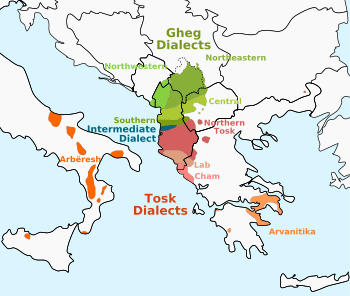
- Proto-Albanian
- Middle Albanian (extinct)
- Modern Albanian (dialect continuum)
- Gheg Albanian
- Northwestern Gheg
- Arbanasi (Albanian of Zadar, Croatia)
- Istrian Albanian (extinct)
- Northeastern Gheg (Northeast Albania and most of Kosovo)
- Central Gheg
- Southern Gheg
- Northwestern Gheg
- Transitional Gheg-Tosk Albanian
- Southern Elbasan
- Southern Peqin
- Northwestern Gramsh
- Tosk Albanian (basis of Standard Modern Albanian but not identical)
- Northern Tosk
- Lab
- Cham
- Arbëresh (Albanian of Southern Italy)
- Arvanitika (Albanian of Central Greece)
- Gheg Albanian
- Modern Albanian (dialect continuum)
- Middle Albanian (extinct)
Anatolian languages (extinct)

- Proto-Anatolian
- Hittite (Nesitic/Central)
- Hittite (Nesili)
- Cappadocian?
- Cataonian?
- Leucosyrian?
- West Pontian?
- Hittite (Nesili)
- Luwic (Southern)
- Western Anatolian? (related to but not part of Luwic)
- Palaic (Northern)
- Palaic
- Cauconian?
- Paphlagonian
- Mariandynian
- Palaic
- Hittite (Nesitic/Central)
Armenian language

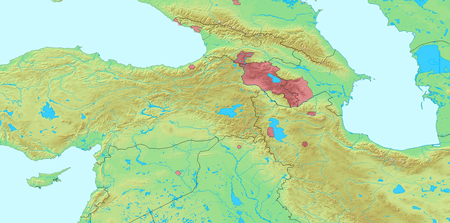
- Proto-Armenian
- Classical Armenian (Old Armenian)
- Middle Armenian
- Modern Armenian (dialect continuum)
- Eastern Armenian (dialect continuum)
- -owm Dialects
- Araratian
- Yerevan (basis of Modern Standard Eastern Armenian)
- Jugha (originally in Julfa) (today in New Julfa) (still spoken by part of the Iranian Armenians)
- Agulis (in Agulis)
- Artsakh (Karabagh)
- Araratian
- -el Dialects (Tayk'-Nor Shirakan)
- Ardvin/Tayk' (in Artvin)
- Nor Shirakan/Parskahayk' (Persarmenia)
- Khoy (in Khoy) (still spoken by part of the Iranian Armenians)
- Maragha Armenian (in Maragheh) (still spoken by part of the Iranian Armenians)
- -owm Dialects
- Western Armenian (dialect continuum)
- -gë Dialects
- Karin/Upper Armenia (Bardzr Hayk')
- Turuberan
- Van/Vaspurakan
- Torfavan subdialect
- Tigranakert Armenian/Aghdznik (Arzanene) (in Diyarbakır) (almost extinct)
- Kharpert-Yerznka/Sophene (Tsopk') (in Elazığ) (almost extinct)
- Trapizon Armenian (in Trabzon) (almost extinct)
- Homshetsi
- Malatia Armenian (in Malatya) (almost extinct)
- Cilician Armenian (almost extinct)
- Syrian Armenian dialect (still spoken by Syrian Armenians)
- Arabkir Armenian (almost extinct)
- Sebastia Armenian (in Sivas) (almost extinct)
- Tokat Armenian (almost extinct)
- Constantinople Armenian (in Istanbul) (almost extinct)
- Crimea Armenian (still spoken by Armenians in Crimea)
- -gë Dialects
- Eastern Armenian (dialect continuum)
- Modern Armenian (dialect continuum)
- Middle Armenian
- Classical Armenian (Old Armenian)
Balto-Slavic languages
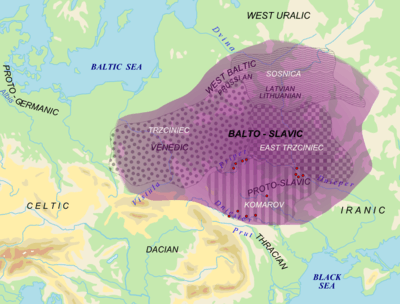

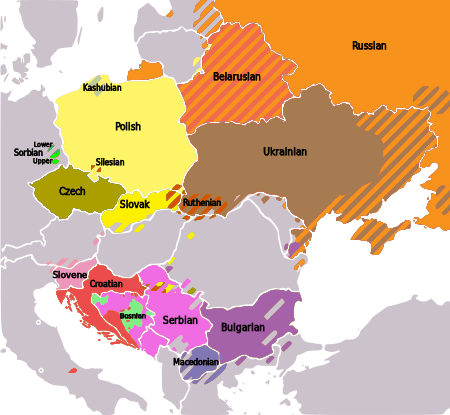
- Proto-Balto-Slavic
- Baltic languages
- Proto-Baltic
- Eastern Baltic languages (Dnieper Basin Baltic) (dialect continuum)
- Dnieper Baltic
- East Galindian (extinct)
- Old Latvian
- Transitional Latvian-Lithuanian
- Selonian (extinct)
- Semigallian (extinct)
- Old Lithuanian
- Dnieper Baltic
- Transitional East-West Baltic
- Curonian (disputed; see Origin of Curonian) (extinct)
- Western Baltic languages (Baltic Sea Coast Baltic) (dialect continuum)
- Old Prussian (extinct)
- New Prussian (Revived Prussian) (50 second language speakers, some children are natively bilingual, being revived) (not confuse with Germanic Prussian)
- Skalvian (extinct)
- West Galindian (extinct)
- Sudovian (Yotvingian) (extinct)
- Old Prussian (extinct)
- Eastern Baltic languages (Dnieper Basin Baltic) (dialect continuum)
- Proto-Baltic
- Slavic languages
- Proto-Slavic
- North Slavic (dialect continuum)
- East Slavic languages/Northeast Slavic (dialect continuum)
- Old Novgorodian-Pskovian (Archaic East Slavic/Northwest Old Slavic or a North Slavic proper group)? (extinct)
- Old Novgorodian (extinct)
- Innovative East Slavic
- Old East Slavic (Old Russian, Old Rusyn, Old Ukrainian and Old Belarusian) (extinct)
- Ruthenian (Old Rusyn, Old Ukrainian and Old Belarusian) (extinct)
- Southwest Old East Slavic (Old Rusyn)
- Rusyn/Carpathian Rusyn (also known as Ruthenian, Rusinian)
- Hutsulian/Gutsulian
- Boykian
- Trans-Carpathian
- Lemkian
- Canadian Ukrainian (more closely related to Rusyn)
- Pannonian Rusyn
- Rusyn/Carpathian Rusyn (also known as Ruthenian, Rusinian)
- Southern Old East Slavic (Old Ukrainian)
- Ukrainian
- Southern
- South-Western (Western South)
- Volynian/Volhylian
- Podilian/Podolian
- Upper Dniestrian
- Sjanian/Sanian/Upper Sanian
- Pokuttyan-Bukovynian
- South-Eastern (Eastern South)
- Middle Dnieprian (includes Kiev, Cherkasy, Poltava) (basis of Modern Standard Ukranian but not identical)
- Kiev (Kyyiv) dialect
- Slobozhan/Slodozian/Slododzian
- Steppe Ukrainian
- Balachka
- Don Cossack
- Black Sea-Kuban Cossack
- Mountain Cossack (North Caucasus Cossack)
- Balachka
- Middle Dnieprian (includes Kiev, Cherkasy, Poltava) (basis of Modern Standard Ukranian but not identical)
- South-Western (Western South)
- Southern
- Transitional Ukrainian-Belarusian (Northern Ukrainian dialects)
- Eastern Polesian
- Central Polesian
- West Polesian
- Ukrainian
- Central Old East Slavic (Old Belarusian)
- Belarusian
- South-Western
- Slutskian
- Mazyrskian
- Hrodzean-Baranavian (Hrodna-Baranavichy)
- Middle (basis of Modern Standard Belarusian but not identical)
- Minskian (Menskian)
- North-Eastern
- Polatskian
- Vitsebskian
- East-Mahilioŭian (East-Mogilevian)
- South-Western
- Belarusian
- Transitional Belarusian-Russian (also included in the western group of Southern Russian dialects)
- Smolenskian (Smolenskiy) (includes Smolensk, Nevel', Klintsy)
- Southwest Old East Slavic (Old Rusyn)
- Northeast Old East Slavic (Old Russian)
- Russian
- Dialects of Primary Formation (Old Russia, settled before 16th century) (Russian Core)
- Southern Russian
- Western Southern Russian (includes Vyaz'ma, Bryansk)
- Transitional group A (includes Mosalsk, Kozelsk)
- Central/Orel-Don (Orlovskiy - Orelian) (includes Oryol/Orel, Kursk, Belgorod) (spoken by many Russians of Eastern Ukraine)
- Transitional group B (Tul'skiy - Tulian) (includes Kaluga, Tula, Serpukhov, Kolomna, Elets, Stary Oskol)
- Eastern Southern Russian (Ryazanskiy - Ryazanian) (includes Ryazan, Lipetsk, Voronezh, Tambov)
- Doukhobor
- Central-Northern Russian/Middle-Northern Russian
- Central Russian/Middle Russian (Transitional Northern-Southern Russian)
- West Central Russian/West Middle Russian (Novgorodskiy - Novgorodian) (Old Novgorodian substrate)
- East Central Russian/East Middle Russian (Moskovskiy - Moskovian)
- Groups with okanye (Vladimirsko-Povolzhskaya - Vladimirian-Volgian) (includes Tver', Klin, Vladimir, Suzdal, Rostov, Ivanovo, Murom, Nizhny Novgorod)
- Groups with akanye (includes Kasimov, Temnikov)
- Moscovian/Moscow dialect (basis of Modern Standard Russian but not identical)
- Chukhloma dialect enclave (with akanye)
- Northern Russian
- Kostroma-Yaroslavl
- Vologda-Vyatka/Vologda-Kirov (Vologodsko-Vyatskiy - Vologdian-Vyatian)
- Transitional groups (Olonetskiy - Olonetsian) (includes Belozersk-Bezhetsk, Onega, Lacha)
- Ladoga-Tikhvin
- Pomor (includes Arkhangelsk and Murmansk)
- Central Russian/Middle Russian (Transitional Northern-Southern Russian)
- Southern Russian
- Dialects of Second Formation (after Russian expansion and conquests from 16th century)
- Samara Russian
- Siberian Russian
- Alaskan Russian (still spoken in some scattered villages in Alaska)
- Dialects of Primary Formation (Old Russia, settled before 16th century) (Russian Core)
- Transitional Russian-Ukrainian
- Russian
- Ruthenian (Old Rusyn, Old Ukrainian and Old Belarusian) (extinct)
- Old East Slavic (Old Russian, Old Rusyn, Old Ukrainian and Old Belarusian) (extinct)
- Old Novgorodian-Pskovian (Archaic East Slavic/Northwest Old Slavic or a North Slavic proper group)? (extinct)
- West Slavic languages/Northwest Slavic (dialect continuum)
- Lechitic
- Old Polish (extinct)
- Polish
- Lesser Polish
- Greater Polish
- Masovian (basis of Modern Standard Polish but not identical)
- Masurian
- Goralian/Podhale (Highlander Polish dialects)
- Polish
- Upper Silesian (Slavic Silesian) (disputed)
- Cieszyn Silesian (Teschin Silesian)
- Pomeranian
- Kashubian
- Slovincian (extinct)
- Polabian (extinct)
- Sorbian (Lusatian)
- Old Polish (extinct)
- Transitional Polish-Czech (Upper Silesian-Czech)
- Czech-Slovak
- Czech
- Transitional Moravian-Slovak
- Slovak
- Western Slovak
- Central Slovak
- Eastern Slovak
- Knaanic (Judaeo-Czech) (from Knaan - Canaan, "language of Canaan") (extinct)
- Lechitic
- East Slavic languages/Northeast Slavic (dialect continuum)
- South Slavic languages (dialect continuum)
- Western South Slavic/Southwest South Slavic (dialect continuum)
- Slovene
- Pannonian (Pannonian Slovene)
- Styrian (Styrian Slovene) (includes Maribor)
- Carinthian (Carinthian Slovene)
- Resian
- Littoral (includes Koper and Piran)
- Upper Carniolan (includes Ljubljana)
- Lower Carniolan
- Rovte
- Transitional Slovene-Serbo-Croatian
- Serbo-Croatian
- Chakavian
- Shtokavian (basis of Serbo-Croatian but not identical)
- Old-Shtokavian
- Western Shtokavian
- Eastern Shtokavian
- Zeta–Raška/Đekavian-Ijekavian (Zeta-South Sandžak) (basis of Standard Montenegrin but not identical)
- Montenegrin (official language of Montenegro)
- Resava-Kosovo/Older Ekavian
- Zeta–Raška/Đekavian-Ijekavian (Zeta-South Sandžak) (basis of Standard Montenegrin but not identical)
- New Shtokavian/Neo-Shtokavian
- Western Shtokavian
- Bosnian-Dalmatian/Western Ikavian/Younger Ikavian
- Eastern Shtokavian
- Šumadija–Vojvodina/Younger Ekavian (in Northern Serbia) (basis of Standard Serbian but not identical)
- Serbian (official language of Serbia)
- Smederevo-Vršac
- Eastern Herzegovinian (basis of Standard Croatian but not identical) (also spoken by most Bosnian and Croatian Serbs/Krajina Serbs)
- Croatian (official language of Croatia)
- Dubrovnik subdialect
- Šumadija–Vojvodina/Younger Ekavian (in Northern Serbia) (basis of Standard Serbian but not identical)
- Western Shtokavian
- Old-Shtokavian
- Slovene
- Transitional West-East South Slavic
- Torlakian (also belong to Old Shtokavian)
- South Morava-Prizren
- Svriljig-Zaplanje
- Timok-Lužnica
- Northern Macedonian dialects (in Kumanovo, Kratovo, Kriva Palanka) (are closer to Torlakian)
- Gora dialect
- Torlakian (also belong to Old Shtokavian)
- Eastern South Slavic/Southeast South Slavic (dialect continuum)
- Old Church Slavonic (extinct)
- Bulgarian-Macedonian
- Bulgarian (Slavic Bulgarian, Seven Tribes Slavic)
- Western Bulgarian
- Northwestern
- Southwestern
- Macedonian (Slavic Macedonian, Vardar Slavic) (often included in the Western Bulgarian dialects of the Eastern South Slavic dialect continuum)
- Eastern Bulgarian
- Balkan (Stara Planina) (Central)
- Moesian (Northeastern)
- Rup (Southeastern)
- Western Bulgarian
- Bulgarian (Slavic Bulgarian, Seven Tribes Slavic)
- Western South Slavic/Southwest South Slavic (dialect continuum)
- North Slavic (dialect continuum)
- Proto-Slavic
- Baltic languages
Celtic languages
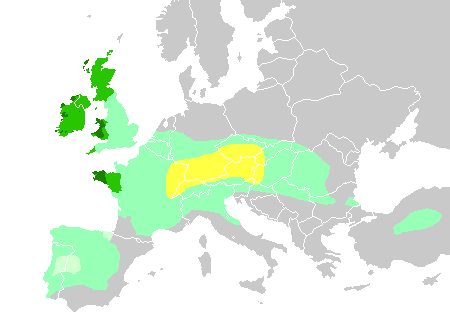

- Proto-Celtic
- Continental Celtic (all extinct; a paraphyletic grouping)
- Eastern Celtic
- Noric? (or unclassified within Celtic)
- Lepontic
- Gaulish? (P Celtic)
- Hispano-Celtic (Q Celtic)
- Celtiberian (Eastern Hispano-Celtic)
- Gallaecian? (Western Hispano-Celtic) (or unclassified within Celtic)
- Eastern Celtic
- Insular Celtic
- Brittonic/British (P Celtic)
- Common Brittonic/Old Brittonic (extinct)
- Eastern Brittonic (extinct after Anglo-Saxonic conquest and settlement in Britannia, today's England)
- Southwestern Brittonic
- Dumnonian (extinct)
- Old Cornish (extinct)
- Middle Cornish (extinct)
- Old Cornish (extinct)
- Old Breton (extinct)
- Middle Breton (extinct)
- Breton (Modern Breton)
- Léonard (Leoneg)
- Trégorrois (Tregerieg)
- Cornouaillais (Kerneveg)
- Vannetais (Gwenedeg)
- Guérandais (in Guérande and Batz-sur-Mer) (extinct)
- Breton (Modern Breton)
- Middle Breton (extinct)
- Dumnonian (extinct)
- Western Brittonic
- Primitive/Archaic Welsh (extinct)
- Old Welsh (extinct)
- Middle Welsh (extinct)
- Welsh (Modern Welsh)
- Gwent and Morgannwg
- Dyfed
- Gwynedd
- Powys
- Patagonian Welsh (in Y Wladfa, Chubut, Patagonia, Argentina)
- Welsh (Modern Welsh)
- Middle Welsh (extinct)
- Old Welsh (extinct)
- Cumbric (extinct)
- Ivernic? (hypothetical) (extinct)
- Primitive/Archaic Welsh (extinct)
- Pictish
- Pictish (may have been a Celtic language possibly related to Brittonic) (extinct)
- Common Brittonic/Old Brittonic (extinct)
- Goidelic (Q Celtic) (dialect continuum)
- Primitive Irish (extinct)
- Old Irish (extinct)
- Middle Irish (extinct)
- Western Gaelic
- Irish Gaelic (Modern Irish) (not confuse with Irish English/Hiberno-English)
- Ulster (Ulaid)
- Connaught (Connacht)
- Munster (an Mhumhain)
- Newfoudland Irish (extinct)
- Leinster (Laighin)
- Meadh and the Pale (Mide/Mí)
- Irish Gaelic (Modern Irish) (not confuse with Irish English/Hiberno-English)
- Transitional Irish-Scottish Gaelic/Western-Eastern Gaelic
- Straits of Moyle (North Channel) Gaelic (extinct)
- Eastern Gaelic
- Scottish Gaelic (not confuse with Scots or Scottish English)
- Lowland Scottish Gaelic (extinct) (former speakers shifted to Scots English)
- Galwegian Gaelic (extinct) (former speakers shifted to Scots English)
- Highland Scottish Gaelic-Islands
- Highland Scottish Gaelic
- Islands
- Hebridean
- Inner Hebridean (almost extinct)
- Outer Hebridean
- Hebridean
- Canadian Gaelic (mainly Cape Breton Island in Nova Scotia)
- Lowland Scottish Gaelic (extinct) (former speakers shifted to Scots English)
- Manx Gaelic (not confuse with Manx English)
- Scottish Gaelic (not confuse with Scots or Scottish English)
- Western Gaelic
- Middle Irish (extinct)
- Old Irish (extinct)
- Primitive Irish (extinct)
- Brittonic/British (P Celtic)
- Continental Celtic (all extinct; a paraphyletic grouping)
Germanic languages
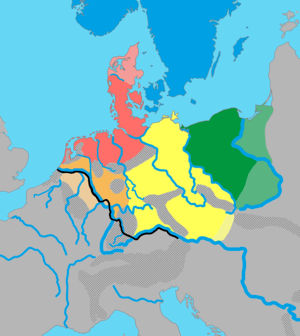

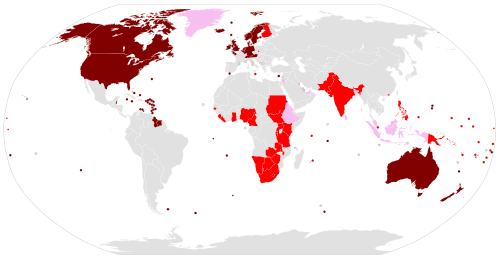
- Proto-Germanic
- East Germanic (most archaic and divergent Germanic group) (all extinct)
- Northwest Germanic (dialect continuum)
- West Germanic (dialect continuum)
- Elbe Germanic (Herminionic/Irminonic/Suebic/Alamanic)
- Lombardic (extinct)
- Suebian/Allemanian (extint)
- High German languages (characterized by the High German consonant shift) (dialect continuum)
- Old High German
- Middle High German
- Early New High German
- New High German
- German
- Central German
- East Central German (basis of Modern Standard High German but not identical)
- Thuringian-Upper Saxon
- Thuringian
- Upper Saxon (not truly Saxon, a North Sea Germanic descendant, but a Elbe Germanic descendant, and close to Thuringian)
- Erzgebirgisch
- Lausatian-Silesian
- High Prussian (not confuse with Baltic Prussian or Old Prussian)
- Thuringian-Upper Saxon
- East Central German (basis of Modern Standard High German but not identical)
- Transitional Central German-Upper German (descends from Elbe Germanic and Weser-Rhine Germanic contact and mixing)
- Upper German
- Wymysorys (Vilamovian)
- New High German
- Early New High German
- Yiddish (Jewish German) (originated in the Rhine Valley)
- Western Yiddish
- Southwest
- West Central
- Northwest
- Transitional Western-Eastern
- South Transitional
- North Transitional
- Eastern Yiddish
- East Central
- Southeast
- Northeast
- Western Yiddish
- Middle High German
- Old High German
- High German languages (characterized by the High German consonant shift) (dialect continuum)
- Weser-Rhine Germanic (Istvaeonic)
- Frankish (Old Franconian)
- West Central German (Central Franconian) (descends from Weser-Rhine Germanic and participate in the High German consonant shift) (dialect continuum)
- Low Franconian languages (descends from Weser-Rhine Germanic but did not participate in the High German consonant shift) (dialect continuum)
- Frankish (Old Franconian)
- North Sea Germanic (Ingvaeonic)
- Old Low German (Old Saxon) (did not participate in the High German consonant shift)
- Middle Low German (Middle Saxon)
- Low German (Modern Low German) (Low Saxon) (dialect continuum)
- East Low German
- Brandenburgisch (Märkisch) (Northern-Central Brandenburgisch)
- Mecklenburgisch-Vorpommersch
- East Pomeranian
- Low Prussian (not confuse with Baltic Prussian or Old Prussian)
- West Low German
- Northern Low Saxon
- Schleswigsch
- Holsteinisch
- Low Elbish
- Oldenburgish
- Bremenian
- North Hanoveranian
- Dithmarsch
- Emsländisch
- East Frisian Low Saxon
- Gronings
- Phalian (Southern Low saxon)
- Eastphalian
- Westphalian
- Northern Low Saxon
- East Low German
- Low German (Modern Low German) (Low Saxon) (dialect continuum)
- Middle Low German (Middle Saxon)
- Anglo-Frisian languages (did not participate in the High German consonant shift)
- Anglic languages (dialect continuum)
- Old English (Anglo-Saxon) (extinct)
- Anglian
- Southumbrian
- East Anglian
- Mercian
- Northumbrian
- Southumbrian
- Jute
- Saxon
- Middle English (extinct)
- Early Modern English
- English (Modern English)
- England English
- Central and Northern English ("Anglian English")
- Central English (Southumbrian)
- North English (Northumbrian)
- South English ("Saxon English")
- Southeast English
- West Country English (Southwest English)
- Central and Northern English ("Anglian English")
- Wales English (Welsh English)
- Scotland English (Scottish English)
- Ulster English/Northern Hiberno-English (not confuse with Ulster Scots)
- Ireland English (Hiberno-English)
- North American English
- Canadian English
- Standard Canadian English
- Atlantic Canadian English
- Inland Canadian English
- Quebec Canadian English (not confuse with Quebec French)
- Ontario Canadian English
- West Canadian English
- Prairies Canadian English
- British Columbia English
- First Nations English/Aboriginal English in Canada
- American English (USA English)
- General American English
- North and West
- Northern New England
- Eastern New England English
- Northeastern New England (includes Boston and Maine)
- Southeastern New England (includes Rhode Island)
- Western New England English
- Northwestern New England (includes Vermont)
- Eastern New England English
- Northern American English (a specific dialect and not synonym of North American English)
- Southwestern New England (Eastern Northern American English)
- Inland Northern American English (Great Lakes)
- Western Northern American English (not confuse with Western American English dialect)
- North Central American English (Upper Midwest)
- New York City English (Metropolitan New York English/Greater New York City English)
- Midland American English (General American has many features of Midland American but is not identical)
- East Midland
- Mid-Atlantic American English (includes Philadelphia and Baltimore)
- Western Pennsylvania English (includes Pittsburgh)
- Central Midland (Lower Midwest)
- West Midland
- Central Nebraska, Kansas and Oklahoma
- El Paso, Texas, Southwest New Mexico, Far Southeast Arizona
- San Francisco Bay Area
- Florida Midland (a new dialect that is no longer Southerner)
- South Florida
- North Florida (but not in Jacksonville and Pensacola that are Southerner)
- Galveston, Texas
- East Midland
- Western American English
- Pacific Northwest English
- Alaska North American English
- Northern New England
- Southern American English
- Lowland South
- Older Southern American English (Classical Southerner)
- General Older South
- Piedmont and Tidewater Virginia
- Plantation Southern American English
- African American English (several common features with Southern American English) (divergent dialect)
- Florida Southerner (many former speakers shifted to a Midland dialect)
- Southern Louisiana
- Cajun English (Cajun French substrate and influence)
- East and South Texas
- Older Southern American English (Classical Southerner)
- General Texan English (features of both Lower South/Lowland South and Upland South/Inland South)
- Upper South/Upland South (Inland Southern American English)
- Appalachian English (in Southern Appalachia) (divergent dialect)
- Ozark Mountains (North Arkansas and South Missouri)
- Southeast and South Oklahoma, North and West Texas, Southeast New mexico
- Peripheral Southerner (Archaic Southerner dialects)
- Chesapeake Islands
- Down East and Outer Banks
- Lowcountry (Charleston-Savannah)
- Lowland South
- Chicano English (English of many Mexican-Americans)
- Canadian English
- Australian-New Zealand English
- Australian English
- New South Wales Australian English
- Victoria Australian English
- Tasmania Australian English
- Queensland Australian English
- South Australian English
- Western Australian English
- Australian Aboriginal English
- Torres Strait English
- New Zealand English
- Australian English
- England English
- Early Scots (extinct)
- Middle Scots (extinct)
- Scots (Modern Scots) (not confuse with Scottish English or Scottish Gaelic)
- Southern Scots
- Central Scots
- Ulster Scots
- Northern Scots
- Insular Scots (Orkney and Shetland)
- Scots (Modern Scots) (not confuse with Scottish English or Scottish Gaelic)
- Middle Scots (extinct)
- English (Modern English)
- Early Modern English
- Anglian
- Frisian languages (dialect continuum)
- Old Frisian
- Middle Frisian
- North Frisian
- Island North Frisian
- Haligolandic Frisian
- Föhr-Amrum Frisian
- Sylt Frisian
- Strand Frisian (extinct)
- Mainland North Frisian
- Wiedingharde Frisian
- Bökingharde Frisian (Mooring)
- Goesharde Frisian
- Halligen Frisian
- Eiderstedt Frisian (extinct)
- Island North Frisian
- East Frisian
- Ems Frisian
- Weser Frisian
- Wangerooge Frisian (extinct)
- Wursten Frisian (extinct)
- West Frisian
- Mainland West Frisian
- Hindeloopen Frisian
- Clay Frisian
- Wood Frisian
- Northern West Frisian
- Southwestern Western Frisian
- Island West Frisian
- Schiermonnikoog
- Aastersk (in Terschelling/Skylge Island)
- Westersk (in Terschelling/Skylge Island)
- Mainland West Frisian
- North Frisian
- Middle Frisian
- Old Frisian
- Old English (Anglo-Saxon) (extinct)
- Anglic languages (dialect continuum)
- Old Low German (Old Saxon) (did not participate in the High German consonant shift)
- Elbe Germanic (Herminionic/Irminonic/Suebic/Alamanic)
- West Germanic (dialect continuum)
- North Germanic (dialect continuum)
- Proto Norse/Proto Scandinavian (extinct)
- Old Norse (extinct)
- Old Gutnish (extinct)
- East Scandinavian (dialect continuum)
- Old East Norse (extinct)
- Old Swedish (extinct)
- Swedish
- Götalandic
- Svealandic
- Mälaren dialect
- Stockholm dialects (basis of Modern Standard Swedish but not identical)
- Mälaren dialect
- North Swedish (Norrlandic)
- East Swedish (Finland Swedish)
- Gutnish (New Gutnish) (Gotland Island)
- Swedish
- Transitional Danish-Swedish
- Old Danish (extinct)
- Middle Danish (extinct)
- Danish
- Eastern Danish
- Island Danish (basis of Modern Standard Danish but not identical)
- Jutlandic
- Dano-Norwegian
- Norwegian Riksmål (written)
- Norwegian Bokmål (written)
- Norwegian Riksmål (written)
- Danish
- Middle Danish (extinct)
- Old Swedish (extinct)
- Old East Norse (extinct)
- Transitional East-West Scandinavian
- Norwegian
- Svorsk (Swedish-Norwegian)
- Dalecarlian
- Jamtlandic
- Norwegian
- West Scandinavian (dialect continuum)
- Old West Norse (extinct)
- Old Norwegian (extinct)
- Middle Norwegian (extinct)
- Norwegian
- Norwegian Høgnorsk (written)
- Norwegian Nynorsk (written)
- West Norwegian (Vestlandsk)
- South
- West
- Trøndelag (Trøndersk)
- East Norwegian (Østandsk)
- North Norwegian
- Norwegian Høgnorsk (written)
- Norwegian
- Faroese
- Norn (Shetland and Orkney) (extinct)
- Middle Norwegian (extinct)
- Icelandic
- Greenlandic Norse (extinct)
- Old Norwegian (extinct)
- Old West Norse (extinct)
- Old Norse (extinct)
- Proto Norse/Proto Scandinavian (extinct)
Hellenic languages (Greek)
_en.svg.png)
| Western group: | Central group: | Eastern group: |


- Proto-Greek
- Mycenaean Greek (extinct)
- Ancient Greek (Classical Greek) (extinct)
- Eastern
- Central (Central Eastern)
- Aeolic Greek (extinct)
- Arcadocypriot (extinct)
- Pamphylian Greek (extinct)
- Eastern (Southern Eastern)
- Ionic (extinct)
- Attic (extinct)
- Koine Greek (extinct)
- Medieval Greek (extinct)
- Greek (Modern Greek)
- Katharevousa
- Demotic (basis of Standard Modern Greek but not identical)
- Southern dialects
- Maniot (in Mani Peninsula) (archaic dialect)
- Central-Northern Greek
- Central Greek (Semi-Northern) (Transitional Southern-Northern Greek)
- Northern dialects
- Thessalian
- Epirote
- Modern Greek Macedonian
- Thracian Greek
- Rumelian
- Lemnos Islander
- Lesbos Islander
- Samos Islander
- Yevanic (Judæo-Greek/Romaniote) (probably extinct)
- Greek (Modern Greek)
- Pontic Greek
- Old Cappadocian Greek (former speakers shifted to a mixed Greek-Turkish language) (extinct) (see Cappadocian Greek)
- Italiot Greek (Magna Graecia Greek, Greek of Italy)
- Medieval Greek (extinct)
- Koine Greek (extinct)
- Attic (extinct)
- Ionic (extinct)
- Central (Central Eastern)
- Western
- Doric (extinct)
- Northwest Doric/Northwest Greek (extinct)
- Locrian Greek (extinct)
- Achaean Doric (extinct)
- Doric proper (extinct)
- Northwest Doric/Northwest Greek (extinct)
- Ancient Macedonian[6] (extinct)
- Doric (extinct)
- Eastern
- Ancient Greek (Classical Greek) (extinct)
- Mycenaean Greek (extinct)
Indo-Iranian languages


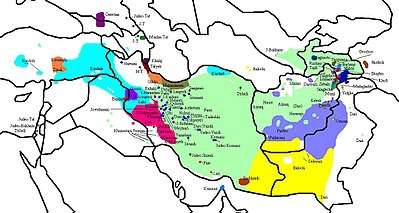
- Proto-Indo-Iranian
- Indo-Aryan languages
- Proto-Indo-Aryan
- Old Indo-Aryan (extinct)
- Vedic Sanskrit (Early Old Indo-Aryan)
- Sanskrit
- Middle Indo-Aryan (Prakrit) (extinct)
- Dardic (The relation of this subgroup to other Indo Aryan languages is unclear.)
- Gandhari Prakrit (extinct)
- North-Western Indo-Aryan (dialect continuum)
- Punjabi languages
- Transitional Punjabi-Sindhi
- Sindhi languages
- Northern Indo-Aryan (dialect continuum)
- Western Indo-Aryan (dialect continuum)
- Gurjar apabhraṃśa (or Old Western Rajasthani/Old Gujarati: common ancestor of Gujarati and Rajasthani)
- Bhil
- Gamit
- Northern Bhil
- Central Bhil
- Bareli
- Kalto (Nahali)
- Khandeshi
- Central Indo-Aryan (Madhya/Hindi) (dialect continuum)
- Sauraseni Prakrit (extinct)
- Transitional Central-Eastern Indo-Aryan (dialect continuum)
- East Central Indo-Aryan languages (Eastern Hindi)
- Eastern Indo-Aryan (dialect continuum)
- Pali (Paiśācī Prakrit?) (extinct)
- Magadhi Prakrit (extinct)
- Apabhramsa Avahatta/Abahatta
- Bihari languages
- Bengali-Assamese languages
- Old Bengali-Assamese/Old Bengali-Kamarupa
- Old Bengali
- Kamarupa
- Old Bengali-Assamese/Old Bengali-Kamarupa
- Odia languages (Oriya)
- Apabhramsa Avahatta/Abahatta
- Transitional Eastern-Southern Indo-Aryan (dialect continuum)
- Southern Indo-Aryan (dialect continuum)
- Maharashtri Prakrit (extinct)
- Marathi–Konkani languages
- Sinhalese-Maldivian languages (Insular Indo-Aryan)
- Unclassified
- Maharashtri Prakrit (extinct)
- Unclassified
- Andh
- Are
- Chinali-Lahul Lohar
- Kanjari
- Kholosi
- Kumhali
- Kuswaric
- Od
- Domari-Romani?
- Proto Domari-Romani (extinct)
- Domari
- Domari ("India and Middle Eastern Gypsy") (in scattered communities in India, Central Asia, the Middle East and North Africa)
- Dombari (in Northern India and Pakistan)
- Dehari (in Haryana)
- Orhi (in Uttar Pradesh and Uttarakhand)
- Kanjari (in Northern India)
- Patharkati (in Northern India and Nepal)
- Mirasi (in Northern India, Punjab)
- Bedi (in Bangladesh)
- Narikurava (in Tamil Nadu)
- Lori (in Balochistan)
- Mugati (Lyuli) (in Central Asian countries)
- Churi-Wali (in Afghanistan)
- Kurbati (Ghorbati) (in Afghanistan and Iran)
- Karachi/Garachi (in Northern Iran and Azerbaijan, Caucasus)
- Marashi (in Marash, southeastern Turkey)
- Barake (in Syria)
- Nawari (in Mesopotamia, Levant, North Africa)
- Palestinian Domari (in the old quarters of Jerusalem)
- Helebi (in North Africa: Egypt, Libya, Tunisia, Algeria and Morocco)
- Halab/Ghajar (in Sudan)
- Old Persian Domari (former speakers shifted to a mixed Persian Romani language) (extinct)
- Seb Seliyer
- Domari ("India and Middle Eastern Gypsy") (in scattered communities in India, Central Asia, the Middle East and North Africa)
- Transitional Domari-Romani
- Old Lomari/Old Lomavren ("Armenian Gypsy") (former speakers shifted to a mixed Romani-Domari-Armenian language, Lomavren) (extinct)
- Romani
- Romani ("Anatolian and European Gypsy") (see also Para-Romani languages) (in scattered communities in Anatolia/Asia Minor, Europe, North and South America)
- Old Persian Romani (former speakers shifted to a mixed Persian Romani language) (extinct)
- Balkan Romani (Anatolia-Balkan Romani)
- Southern Balkan (includes Anatolia) (some speakers shifted to a mixed Romano-Greek language)
- Northern Balkan (Zis) (some speakers shifted to a mixed Romano-Serbian language)
- Vlax Romani
- Northern Vlax
- Southern Vlax
- Northern Romani
- Carpathian Romani (Central Romani)
- Southern Central
- Northern Central
- Old Bohemian Romani (former speakers shifted to a mixed Romani-Czech dialect, Bohemian Romani) (both extinct)
- Northwestern
- Sinte Romani
- Welsh-Romani
- Old Scottish Romani (former speakers shifted to Scottish Cant language) (extinct)
- Old Anglic Romani (former speakers shifted to a mixed Anglo-Romani language) (extinct)
- Old Scandinavian Romani (former speakers shifted to a mixed Scandoromani language) (extinct)
- Old Caló (former speakers shifted to a mixed Romani-Occitan-Ibero Romance language, Modern Caló, and to a mixed Romani-Basque language, Erromintxela) (extinct)
- Northeastern
- Carpathian Romani (Central Romani)
- Romani ("Anatolian and European Gypsy") (see also Para-Romani languages) (in scattered communities in Anatolia/Asia Minor, Europe, North and South America)
- Domari
- Proto Domari-Romani (extinct)
- Savji language
- Vaagri Booli
- Dardic (The relation of this subgroup to other Indo Aryan languages is unclear.)
- Middle Indo-Aryan (Prakrit) (extinct)
- Sanskrit
- Vedic Sanskrit (Early Old Indo-Aryan)
- Old Indo-Aryan (extinct)
- Proto-Indo-Aryan
- Transitional Iranian-Indo-Aryan
- Iranian languages
- Proto-Iranian
- Avestan language
- Eastern Iranian languages
- Northeastern Iranian languages
- Scytho-Sarmatian
- Scytho-Khotanese (Saka) (extinct)
- Khotanese (extinct)
- Tumshuqese (extinct)
- Chorasmian (extinct)
- Sogdian (extinct)
- Southeastern Iranian languages
- Bactrian (extinct)
- Pamirian
- Ormuri-Parachi
- Pakhto/Pashto (dialect continuum)
- Northern Pashto (Pakhto)
- Transitional Northern-Southern Pashto
- Southern Pashto (Pashto)
- Wanetsi (Tarīnō/Chalgarī)
- Northeastern Iranian languages
- Western Iranian languages
- Northwestern Iranian languages
- Parthian (extinct)
- Median (extinct)
- Northwestern I
- Northwestern II
- Tatic
- Tati/Azari
- Tati
- Kiliti (extinct)
- Southern Tati/Ramandi
- Old Azeri/Azari (extinct)
- Harzandi
- Karingani
- Kho'ini
- Khalkhal
- Upper Taromi
- Rudbari
- Eshtehardi
- Takestani (Qazvin)
- Tati
- Talysh
- Transitional Tati-Talysh-Central Iran
- Tafresh
- Ashtiani
- Alviri-Vidari
- Judeo-Hamadani (Judeo-Median of Hamadan, Ecbatana)
- Tafresh
- Central Iran/Central Plateau
- Northwestern Central Iran
- Khunsari
- Mahallati
- Vanishani
- Judeo-Golpaygani (Judeo-Median of Golpaygan)
- Southwestern Central Iran
- Gazi
- Sedehi
- Ardestani
- Nohuji
- Sajzi
- Jarquya’i
- Rudashti
- Kafrudi
- Kafruni
- Judeo-Esfahani (Judeo-Median of Esfahan, Ispahan)
- Northeastern Central Iran
- Arani
- Bidgoli
- Delijani
- Nashalji
- Abuzaydabadi
- Qohrudi
- Badrudi
- Kamu’i
- Jowshaqani
- Meyma’i
- Abyana’i
- Soi
- Badi
- Natanzi
- Kasha’i
- Tari
- Tarqi
- Judeo-Kashani (Judeo-Median of Kashan)
- Southeastern Central Iran
- Zoroastrian Dari
- Nayini
- Zefra’i
- Varzenei
- Tudeshki
- Keyjani
- Abchuya’i
- Northwestern Central Iran
- Tati/Azari
- Kavir
- Balochi (dialect continuum)
- Tatic
- Northwestern III
- Caspian (dialect continuum)
- Gilaki
- Mazanderani
- Gorgani (extinct)
- Deylami (extinct)
- Semnani
- Caspian (dialect continuum)
- Southwestern Iranian languages (dialect continuum)
- Old Persian (extinct)
- Middle Persian (extinct)
- Persian (New Persian)
- Iranian Persian (Western Persian)
- Dari Persian (Eastern Persian)
- Pahlavni (extinct)
- Aimaq
- Hazaragi
- Tajik
- Bukhori (Judeo-Bukharic, Judeo-Persian of Bukhara)
- Tat
- Persian (New Persian)
- Persid
- Larestani–Gulf
- Middle Persian (extinct)
- Old Persian (extinct)
- Northwestern Iranian languages
- Proto-Iranian
- Indo-Aryan languages
Italic languages

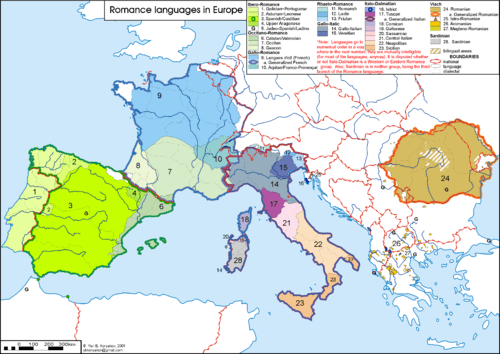
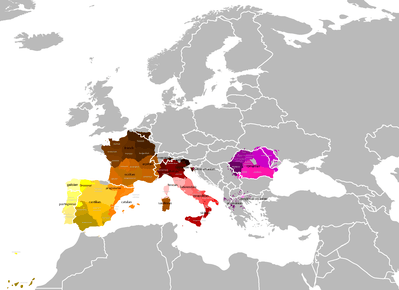

- Proto-Italic
- Osco-Umbrian languages (Sabellic languages) (all extinct)
- Umbrian
- Oscan
- Unclassified (within Italic)
- Latino-Faliscan languages
- Faliscan (extinct)
- Latin (extinct)
- Lanuvian (extinct)
- Praenestinian (extinct)
- Vulgar Latin (Sermo Vulgaris) (extinct)
- Romance languages
- Proto-Romance (extinct)
- Continental Romance
- Italo-Western languages (dialect continuum)
- Italo-Dalmatian languages (dialect continuum)
- Italian
- Old Italian (extinct)
- Central Italian
- Laziale
- Sabino
- Umbrian
- Marchegian
- Southern Italian
- Old Tuscan
- Tuscan
- Northern Tuscan
- Florentine (basis of Modern Standard Italian but not identical)
- Southern Tuscan
- Northern Tuscan
- Corsican
- Tuscan
- Italkian (Judeo-Italian)
- Central Italian
- Old Italian (extinct)
- Dalmatian (Transitional Western-Eastern Romance)
- Italian
- Western Romance languages (dialect continuum)
- Gallo-Romance languages (dialect continuum)
- Gallo-Italic (Cisalpine Romance)
- Emilian-Romagnol
- Transitional Emilian-Lombard
- Lombard-Emilian
- Mantuan
- Vogherese
- Lombard-Emilian
- Lombard
- Transitional Lombard-Piemontese
- Piedmontese
- Judaeo-Piedmontese (extinct)
- Ligurian
- Gallo-Italic of Basilicata
- Gallo-Italic of Sicily
- Venetian
- Central Venetian
- Eastern/Coastal Venetian
- Western Venetian
- North-Central Destra Piave Venetian
- Northern Sinistra Piave Venetian
- Talian
- Gallo-Rhaetian
- Rhaeto-Romance
- Oïl (Northern Gallo-Romance) (Langues d'Oïl) (dialect continuum)
- Old French (extinct)
- Middle French
- Francien/Francilien (Central Oïl)
- French
- European French (French of France)
- Île de France French
- Parisian (basis of Modern Standard French but not identical)
- Orleanais (non-standard dialect of French, true dialect of French )
- Blésois (non-standard dialect of French, true dialect of French)
- Tourangeau (non-standard dialect of French, true dialect of French)
- Île de France French
- Canadian French
- New Foundland French
- Québec French
- Transitional Acadian-Québec French
- Acadian French
- European French (French of France)
- Close and sister languages of French in the Central Oïl dialect continuum
- French
- Burgundian (Southeast Oïl)
- Burgundian-Morvandeau
- Burgundian proper
- Morvandeau
- Frainc-Comtou
- Burgundian-Morvandeau
- Armorican (Western Oïl)
- Poitevin-Saintongeais (Southwest Oïl)
- Frankish (Northern Oïl)
- Picard
- Walloon
- Lorrain
- Old Norman
- Norman
- Auregnais (extinct)
- Guernésiais
- Jèrriais
- Anglo-Norman/Anglo-Norman French (significantly contributed to Middle English vocabulary, many English words of Latin origin came through Anglo-Norman) (extinct)
- Norman
- Francien/Francilien (Central Oïl)
- Middle French
- Moselle Romance (extinct)
- Zarphatic (Judaeo-French) (from Zarpha, Jewish name for France) (extinct)
- Old French (extinct)
- Gallo-Italic (Cisalpine Romance)
- Transitional Franco-Provençal (Northern-Southern Gallo-Romance) (dialect continuum)
- Occitan-Hispanic (Occitan-Ibero-Romance) (dialect continuum)
- Occitan (Southern Gallo-Romance) (Langues d'Oc) (dialect continuum)
- Old Provençal/Old Occitan (extinct)
- Occitan
- Arverno-Mediterranean
- Eastern
- Provençal (includes Niçard/Nissart)
- Vivaro-Alpine (Alpine Provençal, Gavòt)
- Western
- Auvergnat
- Croissant Auvergnat (Bourbonnais d'Oc) (some features are transitional between Oc and Oïl languages)
- Limousin
- Croissant Limousin (some features are transitional between Oc and Oïl languages)
- Auvergnat
- Eastern
- Central Occitan
- Lengadocian (Northern-Central)
- Arverno-Mediterranean
- Shuadit (Judaeo-Provençal/Judaeo-Occitan) (in Comtat Venaissin) (extinct)
- Occitan
- Aquitano-Pyrenean (Transitional Gallo-Iberian-Romance) (dialect continuum)
- Gascon
- Southern Lengadocian (Transitional Gascon-Lengadocian-Catalan)
- Tolosenc
- East Iberian Romance
- Old Catalan (extinct)
- Catalan (Modern Catalan)
- East Catalan
- Northern Catalan (Roussillon Catalan)
- Central Catalan (basis of Modern Standard Catalan but not identical)
- Balearic
- Algherese Catalan (in Algher/Alghero, Sardinia, Italy)
- West Catalan
- Northwestern Catalan (including Lleida/Lerida)
- Valencian
- East Catalan
- Catalanic (Judaeo-Catalan)
- Catalan (Modern Catalan)
- Old Catalan (extinct)
- Old Provençal/Old Occitan (extinct)
- Iberian Romance languages (Hispano-Romance) (dialect continuum)
- Pyrenean (Transitional East-West Iberian Romance)
- Aragonese
- Navarro-Aragonese (extinct)
- Judaeo-Aragonese (extinct)
- Aragonese
- West Iberian Romance proper (West Hispano-Romance proper) (dialect continuum)
- Castilian (dialect continuum)
- Old Castilian (extinct)
- Spanish/Castilian (dialect continuum)
- European Spanish (Spanish of Spain)
- Northern Castilian
- Castilian proper (basis of Modern Standard European Spanish but not identical)
- Old Castile Castilian
- Northern New Castile Castilian
- Cantabrian Castilian (not confuse with Cantabrian)
- Leonese Castilian (not confuse with Leonese language)
- Rioja Castilian
- Navarre Castilian (South Navarre) (not confuse with Navarro-Aragonese)
- Aragonese Castilian (not confuse with Aragonese language)
- Castilian proper (basis of Modern Standard European Spanish but not identical)
- Central-Southern Castilian
- Central Castilian (broad sense) (Southern Castilian in narrow sense) (Transitional Northern-Southern Castilian)
- Castilian proper
- Southern New Castile Castilian
- Madrid Castilian
- Toledo Castilian
- Manchego Castilian (La Mancha Castilian)
- Southern New Castile Castilian
- Murcian
- Eastern Andalusian
- Castilian proper
- Southern Castilian (broad sense) (Andalusian-Canarian)
- Andalusian (Western)
- Canarian
- Central Castilian (broad sense) (Southern Castilian in narrow sense) (Transitional Northern-Southern Castilian)
- Northern Castilian
- Latin American Spanish
- European Spanish (Spanish of Spain)
- Extremaduran (Southern-Central Extremaduran)
- Ladino (Judaeo-Spanish)
- Spanish/Castilian (dialect continuum)
- Old Castilian (extinct)
- Transitional Castilian-Astur-Leonese
- Astur-Leonese
- Old Astur-Leonese (extinct)
- Astur-Leonese (dialect continuum)
- Asturian
- Leonese
- Mirandese
- Extremaduran (Northern Extremaduran)
- Astur-Leonese (dialect continuum)
- Old Astur-Leonese (extinct)
- Galician-Portuguese (dialect continuum)
- Galician-Portuguese (Old Galician-Old Portuguese) (extinct)
- Galician
- Eastern Galician
- Eonavian (Galician-Asturian) (some features are transitional to Asturian)
- Central Galician
- Western Galician
- Fala
- Eastern Galician
- Portuguese
- European Portuguese (Portuguese of Portugal)
- Northern (some features are transitional to Galician)
- Oporto/Porto dialect
- Central-Southern
- Coastal Central (Transitional Northern-Southern) (basis of Modern Standard European Portuguese but not identical)
- Coimbra dialect
- Lisbon dialect
- Inland Southern Central (Beira-Baixa-Far Northern Alto-Alentejo) (a divergent group of Portuguese dialects in phonetics and some vocabulary)
- Southern
- Coastal Central (Transitional Northern-Southern) (basis of Modern Standard European Portuguese but not identical)
- Islander (Geographical Grouping) (a divergent group of Portuguese dialects in phonetics and some vocabulary)
- Azorean
- Madeiran
- Northern (some features are transitional to Galician)
- Brazilian Portuguese (Portuguese of Brazil)
- Northern
- Bahian
- Salvador da Bahia dialect
- Northeast
- Amazonian
- Bahian
- Southern
- Fluminense
- Rio de Janeiro dialect
- Mineiro
- Belo Horizonte dialect
- Sulista (Southern proper)
- São Paulo dialect
- Caipira
- Uruguayan Portuguese/Fronteiriço
- Fluminense
- Northern
- Minderico (originally was a Portuguese-based Cryptolect)
- Judaeo-Portuguese (extinct)
- European Portuguese (Portuguese of Portugal)
- Galician
- Galician-Portuguese (Old Galician-Old Portuguese) (extinct)
- Castilian (dialect continuum)
- Mozarabic (Latino) (extinct) (Uncertain classification within Hispano-Romance/Ibero-Romance, archaic characteristics.)
- Pyrenean (Transitional East-West Iberian Romance)
- Occitan (Southern Gallo-Romance) (Langues d'Oc) (dialect continuum)
- Gallo-Romance languages (dialect continuum)
- Italo-Dalmatian languages (dialect continuum)
- Eastern Romance languages (dialect continuum)
- Pannonian Romance (extinct)
- South-Danubian
- Transitional South-North Danubian
- North-Danubian (dialect continuum)
- Romanian (Daco-Romanian)
- Northern Romanian
- Banatian
- Transylvanian varieties of Romanian (Ardelenesc varieties) (Transitional Banatian-Moldavian) (Geographical Grouping)
- Crișanian (Western Transylvanian)
- Maramureșian (Northern Transylvanian)
- Oașian (Northeastern Transylvanian)
- Central-Southern Transylvanian
- Moldavian
- Northern Dobrujan
- Vlach (Northern and Southern)
- Southern Romanian
- Muntenian (Wallachian) (basis of Modern Standard Romanian but not identical)
- Oltenian
- Southern Dobrujan
- Muntenian (Wallachian) (basis of Modern Standard Romanian but not identical)
- Northern Romanian
- Istro-Romanian
- Romanian (Daco-Romanian)
- Italo-Western languages (dialect continuum)
- Insular Romance (dialect continuum)
- Old Corsican (speakers shifted to a Toscan language in the 13th and 14th centuries) (extinct)
- Sardinian
- African Romance (extinct)
- Continental Romance
- Proto-Romance (extinct)
- Romance languages
- Osco-Umbrian languages (Sabellic languages) (all extinct)
Tocharian languages (extinct)

- Proto-Tocharian
- Tocharian A (Turfanian, East Tocharian or Agnean)
- Tocharian B (Kuchean or West Tocharian)
- Tocharian C (Kroränian or South Tocharian)
Unclassified Indo-European languages (all extinct)
Indo-European languages whose relationship to other languages in the family is unclear
- Ancient Belgian language/Belgic (part of Celtic, related to Celtic, Italic, or part of the Nordwestblock) (possibly part of an older Pre-Celtic Indo-European branch)
- Ancient Ligurian (possibly related to Italic or Celtic)
- Brygian (part of or closely related to Phrygian language and possibly also related to Greek, Phrygian speakers that stayed in Northern Greece and southern Thrace)
- Cimmerian (possibly related to Thracian or Iranian)
- Dardanian (Illyrian, Dacian, mixed Thracian-Illyrian or a transitional Thracian-Illyrian language)
- Lusitanian (part of Celtic, related to Celtic, Ligurian, Italic, Sorothaptic, Nordwestblock, or his own branch) (possibly part of an older Pre-Celtic Indo-European branch)
- Paleo-Balkan languages (Geographical grouping, not genealogical)
- Dacian (possibly related to Thracian)
- Illyrian languages (one is a possible ancestor of Albanian)
- Liburnian (possibly related to Venetic)
- Messapian (possibly related to Illyrian languages, spoken in today's Apulia, Italy, but possibly originated in Dalmatia, Western Balkans)
- Paionian (possibly related to Thracian, Illyrian, or Anatolian)
- Phrygian (may have been more closely related to Greek, also a possible ancestor of Armenian, East Phrygians may have spoken a language ancestor of Armenian)
- Thracian (possibly related to Dacian)
- Venetic (extinct; either Italic or closely related to Italic)
Possible Indo-European languages (all extinct)
Unclassified languages that may have been Indo-European or members of other language families
- Cypro-Minoan
- Elymian
- Eteocypriot
- Gutian
- Minoan
- Paleo-Corsican
- Paleo-Sardinian
- Pelasgian
- Sicanian
- Sicel/Siculian
- Tartessian (part of Celtic, Pre-celtic Indo-European, Anatolian, a divergent branch of Indo-European or an Indo-European related language family?)
- Tyrsenian (a divergent branch of Indo-European or an Indo-European related language family?)
Hypothetical Indo-European languages (all extinct)
Languages that may have existed and may have been Indo-European
- Euphratic/Proto-Euphratean (a hypothetical early Indo-European language that influenced some languages of the Euphrates river basin)
- Sorothaptic (a hypothetical pre-Celtic Bronze Age Indo-European language of the Urnfield culture in the Iberian Peninsula) (possibly part of an older Pre-Celtic Indo-European branch)
References
- ↑ "Ethnologue report for Indo-European". Ethnologue.com.
- ↑ "Ethnologue report for Indo-European". Ethnologue.com.
- ↑ http://www.nature.com/articles/nature14507
- ↑ Roger D. Woodard (2008), "Greek dialects", in: The Ancient Languages of Europe, ed. R. D. Woodard, Cambridge: Cambridge University Press, p. 51.
- ↑ Dawkins, R.M. 1916. Modern Greek in Asia Minor. A study of dialect of Silly, Cappadocia and Pharasa. Cambridge: Cambridge University Press.
- ↑ "Ancient Macedonian". MultiTree: A Digital Library of Language Relationships. Retrieved 28 March 2016.
- ↑ Mallory & Mair (2000), pp. 67, 68, 274.
